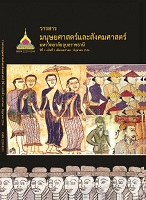แบบจำลองทางความคิดของนักเรียนชั้นประถมศึกษาปีที่ 6 เกี่ยวกับแม่เหล็กและแรงแม่เหล็ก
Main Article Content
บทคัดย่อ
งานวิจัยเชิงคุณภาพนี้มีวัตถุประสงค์เพื่อศึกษาแบบจำลองทางความคิดเกี่ยวกับแม่เหล็กและแรงแม่เหล็ก ของนักเรียนชั้นประถมศึกษาปีที่ 6 จำนวน 17 คน และเปรียบเทียบแบบจำลองทางความคิดเหล่านั้นกับผลการวิจัยของ Erickson (1994) ผู้วิจัยเก็บข้อมูลโดยการสัมภาษณ์นักเรียนแบบกึ่งโครงสร้างรายบุคคล และวิเคราะห์ข้อมูลโดยใช้วิธีการเปรียบเทียบอย่างต่อเนื่อง ผลของการวิจัยนี้เปิดเผยแบบจำลองทางความคิด 4 ประเภท ซึ่งนักเรียนใช้ในการบรรยายและอธิบายการเกิดแรงแม่เหล็ก โดย 3 ใน 4 ประเภทนี้ สอดคล้องกับผลการวิจัยของ Erickson (1994) อย่างไรก็ตาม มีแบบจำลองทางความคิด 1 ประเภท ที่ไม่ปรากฏในผลการวิจัยดังกล่าว บทความวิจัยนี้อภิปรายเกี่ยวกับความเป็นไปได้หนึ่งของการเกิดแบบจำลองประเภทนั้น และนำเสนอแนวทางการนำผลการวิจัยไปใช้ในการจัดการเรียนการสอน
Sixth Graders’ Mental Model about Magnet and Magnetic Force
The purposes of this qualitative research are to examine seventeen sixth graders’ mental models about magnet and magnetic force, as well as to compare and contrast those mental models with the results of Erickson’s (1994) study. The data were collected using individual semi-structured interviews with the students, and analyzed using the constant comparative method. The results of this study reveal four mental models, which the students used to describe and explain how magnetic force occurs. Three of the four mental models are consistent with the results of Erickson’s (1994) study. However, there is one mental model that does not appear in that study. This research article discusses a possibility of how such a mental model occurs, and presents pedagogical implications of this study’s results.
Article Details
บทความที่ได้รับการตีพิมพ์เป็นลิขสิทธิ์ของวารสารมนุษยศาสตร์และสังคมศาสตร์ มหาวิทยาลัยอุบลราชธานี
ข้อความที่ปรากฏในบทความแต่ละเรื่องในวารสารวิชาการเล่มนี้เป็นความคิดเห็นส่วนตัวของผู้เขียนแต่ละท่านไม่เกี่ยวข้องกับมหาวิทยาลัยอุบลราชธานี และคณาจารย์ท่านอื่นๆในมหาวิทยาลัยฯ แต่อย่างใด ความรับผิดชอบองค์ประกอบทั้งหมดของบทความแต่ละเรื่องเป็นของผู้เขียนแต่ละท่าน หากมีความผิดพลาดใดๆ ผู้เขียนแต่ละท่านจะรับผิดชอบบทความของตนเองแต่ผู้เดียว


